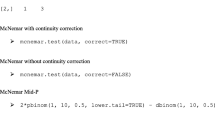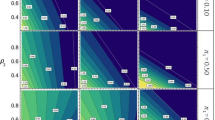Abstract
This simulation-based study assessed the impact of linkage disequilibrium (LD) and epistasis on Hayman’s diallel and generation mean analysis, assuming hundreds of genes, variable degree of dominance, and seven types of digenic epistasis. The diallel parents were 15 doubled haploids from a high LD population. The generation mean analysis was based on seven generations, assuming association. Under low LD and no epistasis, the diallel analysis provided confident results about the inheritance of the quantitative trait and high correlation between number of recessive genes and Wr + Vr, but biased estimates of the dominance components and genetic parameters. The additional consequences of high LD under no epistasis were rejection of the additive-dominance model assuming high heritability and lower correlation. Assuming 100% of epistatic genes, for four epistasis types there was evidence of inadequacy of the additive-dominance model. Assuming 30% of epistatic genes, there was a tendency for accepting the additive-dominance model for low heritability traits and for rejecting for high heritability traits. Linkage and epistasis affect the estimates of the genetic components of the generation means. Even assuming 100% of interacting genes, for most epistasis types there was no statistical evidence of epistasis. Assuming positive partial dominance, the signs of the epistatic components do not allow discriminate complementary, recessive, dominant and recessive, duplicate genes with cumulative effects, and non-epistatic genic interaction. Negative epistatic components evidence dominant epistasis. When the additive × additive and dominance × dominance components are positive and the additive × dominance component is negative, there is duplicate epistasis.
Similar content being viewed by others
Data availability
The dataset is available at https://doi.org/10.6084/m9.figshare.16732888.v1.
References
Addy S, Cichy KA, Adu-Dapaah H, Asante IK, Emmanuel A, Offei SK (2020) Genetic studies on the inheritance of storage-induced cooking time in cowpeas Vigna unguiculata (L.) Walp. Front Plant Sci 11:444. https://doi.org/10.3389/fpls.2020.00444
Andrade ACB, Viana JMS, Pereira HD, Pinto VB, Fonseca ESF (2019) Linkage disequilibrium and haplotype block patterns in popcorn populations. PLoS One 14(9):e0219417. https://doi.org/10.1371/journal.pone.0219417
Coughtrey A, Mather K (1970) Interaction and gene association and dispersion in diallel crosses where gene frequencies are unequal. Heredity 25:79–88. https://doi.org/10.1038/hdy.1970.7
de Lima VJ, Amaral ATD, Kamphorst SH, Bispo RB, Leite JT, Santos TD, Schmitt KFM, Chaves MM, de Oliveira UA, Santos P, Goncalves GMB, Khan S, Guimaraes LJM (2019) Combined dominance and additive gene effects in trait inheritance of drought-stressed and full irrigated popcorn. Agron-Basel 9(12):782. https://doi.org/10.3390/agronomy9120782
Gardner CO, Eberhart SA (1966) Analysis and interpretation of the variety cross diallel and related populations. Biometrics 22(3):439–452
Griffing B (1956a) Concept of general and specific combining ability in relation to diallel crossing systems. Aust J Biol Sci 9:463–493
Griffing B (1956b) A generalised treatment of the use of diallel crosses in quantitative inheritance. Heredity 10:31–50
Hayman BI (1954) The theory and analysis of diallel crosses. Genetics 39:789–809
Hill J (1964) Effects of correlated gene distributions in analysis of diallel crosses. Heredity 19(1):27. https://doi.org/10.1038/hdy.1964.3
Hill WG, Maki-Tanila A (2015) Expected influence of linkage disequilibrium on genetic variance caused by dominance and epistasis on quantitative traits. J Anim Breed Genet 132(2):176–186. https://doi.org/10.1111/jbg.12140
Hill WG, Goddard ME, Visscher PM (2008) Data and theory point to mainly additive genetic variance for complex traits. Plos Genet 4(2):e1000008. https://doi.org/10.1371/journal.pgen.1000008
Kadam DC, Potts SM, Bohn MO, Lipka AE, Lorenz AJ (2016) Genomic prediction of single crosses in the early stages of a maize hybrid breeding pipeline. G3-Gen Genom Genet 6(11):3443–3453
Kalinina EY, Lyakh VA (2011) Genetic control systems of stem branching and plant height in linseed. Cytol Genet 45(2):101–105. https://doi.org/10.3103/s0095452711020058
Kempthorne O (1956) The theory of the diallel cross. Genetics 41(4):451–459
Leng YF, Lv CX, Li LJ, Xiang Y, Xia C, Wei RJ, Rong TZ, Lan H (2019) Heterotic grouping based on genetic variation and population structure of maize inbred lines from current breeding program in Sichuan province, Southwest China using genotyping by sequencing (GBS). Mol Breed 39(3):1–9. https://doi.org/10.1007/s11032-019-0946-y
Makumbi D, Alvarado G, Crossa J, Burgueno J (2018) SASHAYDIALL: a SAS program for hayman’s diallel analysis. Crop Sci 58(4):1605–1615. https://doi.org/10.2135/cropsci2018.01.0047
Mather K (1967) Complementary and duplicate gene interactions in biometrical genetics. Heredity 22:97–000. https://doi.org/10.1038/hdy.1967.8
Mather K, Jinks JJ (1971) Biometrical genetics. Cornell University Press, New York
Mohammed R, Are AK, Munghate RS, Gaddameedi A, Bilhan KKP, Sharma HC (2018) Pattern of genetic inheritance of morphological and agronomic traits of sorghum associated with resistance to sorghum shoot fly Atherigona soccata. Euphytica. https://doi.org/10.1007/s10681-018-2111-9
Mowers RP, Nyhus KA, Tragesser SL, Foster DJ (2018) Doubled haploid testcross design for predicting corn hybrid performance using molecular markers. Crop Sci 58(2):521–528. https://doi.org/10.2135/cropsci2017.02.0086
Nassar RF (1965) Effect of correlated gene distribution due to sampling on diallel analysis. Genetics 52(1):9–000
Pal S, Rao ES, Sriram S (2020) Genetic analysis of resistance to Fusarium oxysporum f. sp. niveum race 2 in cultivated watermelon Citrullus lanatus (Thunb) Matsum & Nakai. Australas Plant Pathol 49(3):319–326. https://doi.org/10.1007/s13313-020-00708-6
Pereira HD, Viana JMS, Andrade ACB, Silva FFE, Paes GP (2018) Relevance of genetic relationship in GWAS and genomic prediction. J Appl Genet 59(1):1–8. https://doi.org/10.1007/s13353-017-0417-2
Pessoa AMS, Rego ER, Dos Santos CAP, de Carvalho MG, do Rego MM (2019) Inheritance of seedling and plant traits in ornamental pepper (Capsicum annuum). Genet Mol Res 18(1):18120. https://doi.org/10.4238/gmr18120
Rai AK, Sadashiva AT, Basavaraj YB, Venugopalan R, Rao ES, Nandeesha P (2020) Genetic analysis of bud necrosis disease caused by groundnut bud necrosis virus (GBNV) in tomato (Solanum lycopersicum L.). Euphytica 216(8):1–10. https://doi.org/10.1007/s10681-020-02657-z
Shahadati-Moghaddam Z, Bagheri N, Jelodar NB, Kiani G, Hosseininejad SA (2017) Inheritance of southern root-knot nematode resistance in air-cured tobacco. Trop Plant Pathol 42(1):32–38. https://doi.org/10.1007/s40858-016-0122-4
Shirinpour M, Asghari A, Aharizad S, Rasoulzadeh A, Khorasani SK (2020) Genetic interaction and inheritance of biochemical traits can predict tolerance of hybrid maize cv. SC704 to drought. Acta Physiol Plant 42(7):1–13. https://doi.org/10.1007/s11738-020-03110-3
Verma A, Singh Y (2018) Generation mean analysis of horticultural traits in mid-late cauliflower (Brassica oleracea L. var. botrytis) under sub temperate conditions of Western Himalayas. Plant Breed 137(1):97–108. https://doi.org/10.1111/pbr.12556
Verma A, Singh Y (2019) Estimation of genetic architecture of biochemical traits in mid-late cauliflower (Brassica oleracea L. var. botrytis) under sub-temperate conditions of north western Himalayas. J Genet 98(1):1–9. https://doi.org/10.1007/s12041-019-1073-6
Viana JMS, DeLima RO, Mundim GB, Teixeira Conde AB, Vilarinho AA (2013a) Relative efficiency of the genotypic value and combining ability effects on reciprocal recurrent selection. Theor Appl Genet 126(4):889–899. https://doi.org/10.1007/s00122-012-2023-3
Viana JMS, Pereira HD, Mundim GB, Piepho HP, Silva FFE (2018) Efficiency of genomic prediction of non-assessed single crosses. Heredity 120(4):283–295. https://doi.org/10.1038/s41437-017-0027-0
Viana JMS, Risso LA, Oliveira deLima R, Fonseca e Silva F (2020) Factors affecting heterotic grouping with cross-pollinating crops. Agron J 113(1):210–223. https://doi.org/10.1002/agj2.20485
Viana JMS, Silva FF, Mundim GB, Azevedo CF, Jan HU (2017) Efficiency of low heritability QTL mapping under high SNP density. Euphytica 213(1):1–11. https://doi.org/10.1007/s10681-016-1800-5
Viana JMS, Valente MSF, Silva FF, Mundim GB, Paes GP (2013b) Efficacy of population structure analysis with breeding populations and inbred lines. Genetica 141(7–9):389–399. https://doi.org/10.1007/s10709-013-9738-1
Yu KC, Wang H, Liu XG, Xu C, Li ZW, Xu XJ, Liu JC, Wang ZH, Xu YB (2020) Large-scale analysis of combining ability and heterosis for development of hybrid maize breeding strategies using diverse germplasm resources. Front Plant Sci 11:660. https://doi.org/10.3389/fpls.2020.00660
Acknowledgements
I thank the National Council for Scientific and Technological Development (CNPq), the Brazilian Federal Agency for Support and Evaluation of Graduate Education (Capes; Finance Code 001), and the Foundation for Research Support of Minas Gerais State (Fapemig) for financial support.
Funding
The authors have not disclosed any funding.
Author information
Authors and Affiliations
Contributions
The author planned the study, developed the theory, programmed the software, processed the data, and wrote the manuscript.
Corresponding author
Ethics declarations
Conflict of interest
The author has no relevant financial or non-financial interest to disclose. The author has no competing interest to declare that are relevant to the content of this article. The author certifies that he has no affiliations with or involvement in any organization or entity with any financial interest or non-financial interest in the subject matter or materials discussed in this manuscript. The author has no financial or proprietary interest in any material discussed in this article.
Additional information
Publisher's Note
Springer Nature remains neutral with regard to jurisdictional claims in published maps and institutional affiliations.
Electronic supplementary material
Below is the link to the electronic supplementary material.
Appendix
Appendix
The expectation of the epistatic effects in the Fn+2 generation is \(E\left( I \right)^{\left( n \right)} = E\left( I \right)^{\left( 0 \right)} + p_{22}^{\left( n \right)} I_{22} + p_{21}^{\left( n \right)} I_{21} + p_{20}^{\left( n \right)} I_{20} + p_{12}^{\left( n \right)} I_{12} + p_{11}^{\left( n \right)} I_{11} + p_{10}^{\left( n \right)} I_{10} + p_{02}^{\left( n \right)} I_{02} + p_{01}^{\left( n \right)} I_{01} + p_{00}^{\left( n \right)} I_{00}\), where n is the number of selfing generations and
where \(F = 1 - \left( {1/2} \right)^{n}\) is the inbreeding coefficient, \(f_{ij}^{\left( 0 \right)}\) is a genotype probability in F2 (i and j = 2, 1, or 0), \(c = 1 - 2r\left( {1 - r} \right)\), \(P_{1}^{\left( n \right)} = \left( {1/4} \right)\left\{ {\left[ {F - \left( {1 - F} \right)\left( {1 - c^{n} } \right)} \right]f_{11}^{\left( 0 \right)} + c_{1}^{\left( n \right)} \left( {1 - 2r} \right)\Delta } \right\}\), \(P_{2}^{\left( n \right)} = \left( {1/4} \right)\left\{ {\left[ {F - \left( {1 - F} \right)\left( {1 - c^{n} } \right)} \right]f_{11}^{\left( 0 \right)} - c_{1}^{\left( n \right)} \left( {1 - 2r} \right)\Delta } \right\}\), \(c_{1}^{\left( n \right)} = \left\{ {2\left[ {1 - \left( {\left( {1 - 2r} \right)/2} \right)^{n} } \right]/\left( {1 + 2r} \right)} \right\}\), and \(\left| \Delta \right| = \left( {1 - 2r} \right)/4\) (positive for coupling and negative for repulsion). Defining \(P_{11}^{\left( 0 \right)}\), \(P_{10}^{\left( 0 \right)}\), \(P_{01}^{\left( 0 \right)}\), and \(P_{00}^{\left( 0 \right)}\) as the gamete probabilities of the F1, where, for example, \(P_{11}^{\left( 0 \right)} = P_{00}^{\left( 0 \right)} = \left( {1 - r} \right)/2\) and \(P_{10}^{\left( 0 \right)} = P_{01}^{\left( 0 \right)} = r/2\) for coupling, the probability of the genotype AABb in F2 is \(f_{21}^{\left( 0 \right)} = 2P_{11}^{\left( 0 \right)} P_{10}^{\left( 0 \right)}\).
Rights and permissions
About this article
Cite this article
Viana, J.M.S. The impact of linkage disequilibrium and epistasis in the studies of inheritance based on Hayman’s diallel and generation mean analysis. Euphytica 218, 63 (2022). https://doi.org/10.1007/s10681-022-03010-2
Received:
Accepted:
Published:
DOI: https://doi.org/10.1007/s10681-022-03010-2




